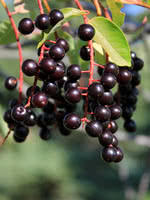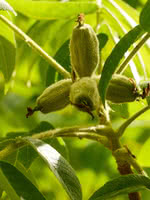Mon-Fri 9am - 5pm Mountain time
Western Chokecherry vs Butternut (White Walnut)
Prunus virginiana var. demissa
Juglans cinerea
Western Chokecherry is a shrub or small tree commonly used for farmstead and field windbreaks.
It produces white flowers in the spring and edible dark purple fruit that matures between September and October. Its cherries are great for making for making jams, jellies or wine, but are not very palatable for raw eating.
Butternut is one of the few walnut varieties native to Canada. The nuts are sought after for their mild, sweet, and oily taste. Ensure this tree is planted in full sun and well-drained soil for best results.
Butternut is self-fertile but it has better yields when planted near other butternuts. It can survive in zone 2, but reliably produces nuts in zone 3.
A top CO2 absorbing species. Experts think this tree may help climate change more than others.
Western Chokecherry Quick Facts
Butternut (White Walnut) Quick Facts
Toxicity: toxic to horses, cattle, etc.)

